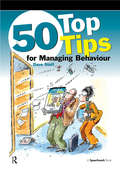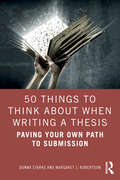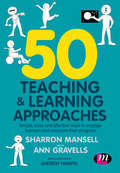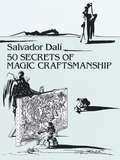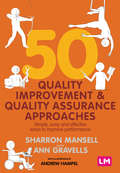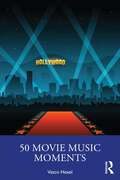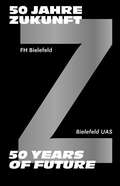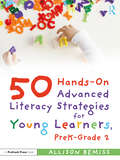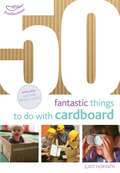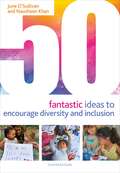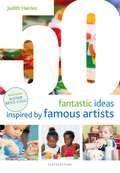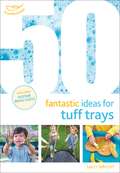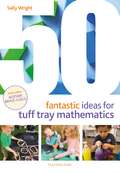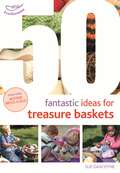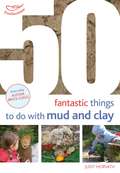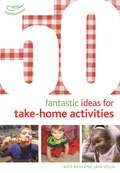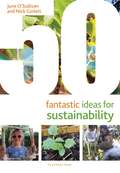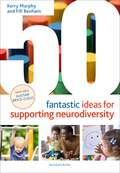- Table View
- List View
50 Top Tips for Managing Behaviour
by Dave StottA practical resource that utilises the SEBS philosophy (Teaching Social, Emotional and Behavioural Skills). With a very 'hands-on' approach to managing behaviour all the scenarios in this resource are taken from real-life situations and can be used during staff training or simply as a reference book. The book reflects situations that confront educational professionals on a day-to-day basis: how to manage the student who always wants the last word; setting boundaries; managing anger, including your own; dealing with difficult parents; successful lunchtimes; creating an emotionally literate environment; behaviour plans; building self-esteem; and, coping with difficult colleagues. It is a brilliant resource to have as part of an induction pack or as an essential companion to continuing professional development. It deals with all key stages.
50 Top Tips for Managing Behaviour
by Dave StottA practical resource that utilises the SEBS philosophy (Teaching Social, Emotional and Behavioural Skills). With a very 'hands-on' approach to managing behaviour all the scenarios in this resource are taken from real-life situations and can be used during staff training or simply as a reference book. The book reflects situations that confront educational professionals on a day-to-day basis: how to manage the student who always wants the last word; setting boundaries; managing anger, including your own; dealing with difficult parents; successful lunchtimes; creating an emotionally literate environment; behaviour plans; building self-esteem; and, coping with difficult colleagues. It is a brilliant resource to have as part of an induction pack or as an essential companion to continuing professional development. It deals with all key stages.
50 Things to Think About When Writing a Thesis: Paving Your Own Path to Submission
by Donna Starks Margaret J. RobertsonMoving away from a traditional ‘one size fits all’ approach, this thesis guide encourages readers to find their own path to submission, demonstrating that the process of writing is as unique as the individual candidate. This book shows thesis writers how to embrace the individual nature of writing, bringing their own unique identities and skillsets to their thesis. Each idea is presented as one that has multiple solutions, depending on who the readers are and what they want to achieve. The book guides the reader on identifying their own ways of working, their own particular strengths, as well as their unique voice and how to use these as tools to navigate the process of writing and surviving the thesis. It also provides practical guidance on elements such as the literature review and methodology, considerations around language and how to deal with life after submission. Offering a unique perspective on the process and experience of completing a thesis, this book will be an essential companion for students completing a thesis at Honors, Master's or PhD level.
50 Things to Think About When Writing a Thesis: Paving Your Own Path to Submission
by Donna Starks Margaret J. RobertsonMoving away from a traditional ‘one size fits all’ approach, this thesis guide encourages readers to find their own path to submission, demonstrating that the process of writing is as unique as the individual candidate. This book shows thesis writers how to embrace the individual nature of writing, bringing their own unique identities and skillsets to their thesis. Each idea is presented as one that has multiple solutions, depending on who the readers are and what they want to achieve. The book guides the reader on identifying their own ways of working, their own particular strengths, as well as their unique voice and how to use these as tools to navigate the process of writing and surviving the thesis. It also provides practical guidance on elements such as the literature review and methodology, considerations around language and how to deal with life after submission. Offering a unique perspective on the process and experience of completing a thesis, this book will be an essential companion for students completing a thesis at Honors, Master's or PhD level.
50 Teaching and Learning Approaches: Simple, easy and effective ways to engage learners and measure their progress
by Ann Gravells Sharron Mansell Andrew HampelThis reader-friendly and accessible text introduces 50 teaching and learning approaches and explores how they work in practice by taking an honest look at the advantages and disadvantages of each one. For each approach, the authors include in-practice examples taken from a range of teaching contexts. The text also offers clear support for teachers on how they can assess learners' progress when using each approach. This focus on the need to see and measure the learning that is taking place supports the reader to concentrate on the learning and not be distracted with the newness of different approaches.
50 Teaching and Learning Approaches: Simple, easy and effective ways to engage learners and measure their progress
by Sharron Mansell Ann Gravells Andrew HampelThis reader-friendly and accessible text introduces 50 teaching and learning approaches and explores how they work in practice by taking an honest look at the advantages and disadvantages of each one. For each approach, the authors include in-practice examples taken from a range of teaching contexts. The text also offers clear support for teachers on how they can assess learners' progress when using each approach. This focus on the need to see and measure the learning that is taking place supports the reader to concentrate on the learning and not be distracted with the newness of different approaches.
50 Secrets of Magic Craftsmanship (Dover Fine Art, History of Art)
by Salvador DaliFor many, Salvador Dalí (1904–1989) represents the Surrealist painter par excellence, one whose work explored his own dream life, hallucinations, and fetishes in the process of objectifying the irrational elements of the unconscious. In this rare and important volume, the painter expresses (in his inimitably eccentric fashion) his ideas of what painting should be, expounds on what is good and bad painting, offers opinions on the merits of Vermeer, Picasso, Cézanne, and other artists, and expresses his thoughts on the history of painting. In a blend of outrageous egotism and unconventional humor, Dalí presents 50 "secrets" for mastering the art of painting: "the secret of sleeping while awake," "the secret of the periods of carnal abstinence and indulgence to be observed by the painter," "the secret of the painter's pointed mustaches," "the secret of learning to paint before knowing how to draw," "the secret of the painter's marriage," "the secret of the reason why a great draughtsman should draw while completely naked," and many other Daliesque prescriptions for artistic success.Illustrated with the artist's own drawings, this volume is a fascinating mixture of serious artistic advice, lively personal anecdotes, and academic craftsmanship. It is, according to the San Francisco Chronicle, "in lay-out and clarity of design . . . a remarkable work of art in itself." Especially esteemed for its insights into modern art, 50 Secrets of Magic Craftsmanship is indispensable reading for any student of Surrealism or 20th century painting.
50 Quality Improvement and Quality Assurance Approaches: Simple, easy and effective ways to improve performance
by Sharron Mansell Ann Gravells Andrew HampelA practical guide containing 50 different quality improvement and quality assurance approaches to help improve practice. · Helps staff to improve the quality of the products and services offered · Includes practical ideas for internal and external quality assurance activities (IQA/EQA) · Helps staff to prepare for external inspections and EQA visits · Readable, relevant and easy to understand · Provides valuable ideas and tips for new and experienced quality staff · Uses simple language to explain each approach · Can help promote outstanding teaching and learning
50 Quality Improvement and Quality Assurance Approaches: Simple, easy and effective ways to improve performance
by Sharron Mansell Ann Gravells Andrew HampelA practical guide containing 50 different quality improvement and quality assurance approaches to help improve practice. · Helps staff to improve the quality of the products and services offered · Includes practical ideas for internal and external quality assurance activities (IQA/EQA) · Helps staff to prepare for external inspections and EQA visits · Readable, relevant and easy to understand · Provides valuable ideas and tips for new and experienced quality staff · Uses simple language to explain each approach · Can help promote outstanding teaching and learning
50 Quality Improvement and Quality Assurance Approaches: Simple, easy and effective ways to improve performance
by Sharron Mansell Ann Gravells Andrew HampelA practical guide containing 50 different quality improvement and quality assurance approaches to help improve practice. · Helps staff to improve the quality of the products and services offered · Includes practical ideas for internal and external quality assurance activities (IQA/EQA) · Helps staff to prepare for external inspections and EQA visits · Readable, relevant and easy to understand · Provides valuable ideas and tips for new and experienced quality staff · Uses simple language to explain each approach · Can help promote outstanding teaching and learning
50 Movie Music Moments
by Vasco Hexel50 Movie Music Moments comprises a wide-ranging collection of analyses of some of the most fascinating uses of music in modern Hollywood cinema. Considering narrative strategies, filmmaking techniques, functions of film music, audience engagement and conditioning, cultural implications, and intertextuality, the case studies gathered here introduce music as a crucial element of film. In 50 examples drawn from popular and critically acclaimed Hollywood films from the late 1950s to the present, the collection showcases the many dimensions of film music and its role in cinematic storytelling. Each example includes an analysis addressing the film’s context and providing a close reading of how music, narrative, and visual elements of the scene interact. Case studies exploring the role of music in film include Amadeus, Gladiator, Baby Driver, The Dark Knight, Philadelphia, Schindler’s List, and Black Panther. This invaluable collection offers an ideal resource to support undergraduate and graduate courses in film music history, film scoring, and filmmaking, as well as readers with a general interest in music in film.
50 Movie Music Moments
by Vasco Hexel50 Movie Music Moments comprises a wide-ranging collection of analyses of some of the most fascinating uses of music in modern Hollywood cinema. Considering narrative strategies, filmmaking techniques, functions of film music, audience engagement and conditioning, cultural implications, and intertextuality, the case studies gathered here introduce music as a crucial element of film. In 50 examples drawn from popular and critically acclaimed Hollywood films from the late 1950s to the present, the collection showcases the many dimensions of film music and its role in cinematic storytelling. Each example includes an analysis addressing the film’s context and providing a close reading of how music, narrative, and visual elements of the scene interact. Case studies exploring the role of music in film include Amadeus, Gladiator, Baby Driver, The Dark Knight, Philadelphia, Schindler’s List, and Black Panther. This invaluable collection offers an ideal resource to support undergraduate and graduate courses in film music history, film scoring, and filmmaking, as well as readers with a general interest in music in film.
50 Jahre Zukunft - FH Bielefeld 1971-2021: 50 Years of Future - Bielefeld UAS 1971-2021
by Andreas BeaugrandSeit ihrer Gründung am 1. August 1971 entwickelte sich die FH Bielefeld bis heute zur größten Hochschule für angewandte Wissenschaften in Ostwestfalen-Lippe - mit über 11.000 Studierenden, mehr als 230 Professor*innen und 630 Mitarbeitenden sowie seit 2015 mit einem beeindruckenden zentralen Hochschulgebäude am Campus Bielefeld. In dem anlässlich des 50. Jubiläums der Hochschule erscheinenden Buch berichten 90 Autor*innen aus Wissenschaft, Wirtschaft, Kultur und Politik über Bildung, Forschung, Lehren und Lernen und werfen so individuelle Schlaglichter auf Momente, Ereignisse und Erlebnisse aus Vergangenheit, Gegenwart und Zukunft der Bildung.
50 Hands-On Advanced Literacy Strategies for Young Learners, PreK-Grade 2
by Allison Bemiss50 Hands-On Advanced Literacy Strategies for Young Learners, PreK–Grade 2 is your go-to resource for lessons, strategies, and activities to foster the key skills and thinking strategies needed to excel in literacy. The hands-on, minds-on literacy explorations in this book are designed to feel a lot like play, but are rooted in the foundational literacy practices that all young learners need. Packed with engaging and helpful reproducibles, each activity is thoughtfully laid out with skill(s), materials, introduction, hands-on task, and reflection sections to maximize student learning. Instructions on how to scaffold experiences for a wider range of ages and developmental readiness levels make this resource imminently flexible. Ideal for learners in grades PreK–2, this book is for teachers, curriculum coaches, parents, librarians, and community educators looking to work on target literacy skills.
50 Hands-On Advanced Literacy Strategies for Young Learners, PreK-Grade 2
by Allison Bemiss50 Hands-On Advanced Literacy Strategies for Young Learners, PreK–Grade 2 is your go-to resource for lessons, strategies, and activities to foster the key skills and thinking strategies needed to excel in literacy. The hands-on, minds-on literacy explorations in this book are designed to feel a lot like play, but are rooted in the foundational literacy practices that all young learners need. Packed with engaging and helpful reproducibles, each activity is thoughtfully laid out with skill(s), materials, introduction, hands-on task, and reflection sections to maximize student learning. Instructions on how to scaffold experiences for a wider range of ages and developmental readiness levels make this resource imminently flexible. Ideal for learners in grades PreK–2, this book is for teachers, curriculum coaches, parents, librarians, and community educators looking to work on target literacy skills.
50 Fantastic Things to do with Cardboard (50 Fantastic Ideas)
by Judit Horvath Alistair Bryce-CleggIn order to be able to think creatively, children have to be encouraged to use their imaginations and play autonomously. When setting up open-ended learning opportunities that stimulate children to investigate possibilities practitioners need easily accessible, cost effective resources. The rationale behind using cardboard boxes is the simple fact that they are cheap and open-ended, meaning they can be easily sourced and simply transformed by both adults and children. A cardboard box is a resource that when left alone, does nothing in particular but comes to life in the hands of children, requiring them to use their imagination or to build on their past experiences. Boxes as open-ended materials greatly enhance the play experience, as they require children to bring their thoughts into the play experience in a deeper way.
50 Fantastic Ideas to Encourage Diversity and Inclusion (50 Fantastic Ideas)
by June O'Sullivan Nausheen KhanA collection of 50 fun and effective activities to nurture kindness and inclusivity in your Early Years setting.Covering important topics such as race, disability, age, appearance and mental health with positivity and openness, this book gives practitioners the confidence to build an inclusive environment for all children. Following the belief that children can be active agents of change, the ideas encourage children to ask questions, challenge prejudice and celebrate diversity through games, provocations, role play, physical activity, arts and crafts and more. With over 40 books in the 50 Fantastic Ideas series there's something for everyone – whether you're a practitioner looking for new ideas or you want to try out a popular well-loved activity with a new twist. Each book offers a wide range of fun and creative activities to carry out with children aged 0–5 years, with lists of resources, step-by-step instructions and information about the benefits for children.
50 Fantastic Ideas Inspired by Famous Artists
by Judith Harries50 Fantastic Ideas Inspired by Famous Artists uses well-known art as a visual inspiration to develop expressive art and design skills in the Early Years. It is much easier now to access art online and to bring inspirational pieces into a setting without having to buy postcards or visit an art gallery. Drawing on these readily available online sources, Judith Harries presents 50 ideas featuring a range of diverse artists from Lubaina Himid and Friedensreich Hundertwasser to Mary Delany and Picasso, and famous art including pop and street art, sculpture and portraiture.Using art supplies easily found in and outside the classroom such as paints, clay, pipe cleaners and natural resources like leaves and flowers, the interactive activities found in this book are ideal for inspiring creativity and fun at the same time!
50 Fantastic Ideas for Tuff Trays (50 Fantastic Ideas)
by Sally Wright Alistair Bryce-CleggThe tuff tray is a staple resource that is often abandoned or underused in early years settings. However, when used effectively, a tuff tray can enhance a child's learning through its versatile usage, such as messy play or as enhancements to support themes and ideas that are being explored. A simple tuff tray provocation can offer many learning opportunities to help a child progress and develop, as its sensory play approach promotes open-ended investigations and problem solving. 50 Fantastic Ideas for Tuff Trays is packed full of exciting activities that are not only simple and easy to prepare and manage, but that also use materials and tools found in most settings and at very low cost. With ideas for tuff trays that support books, promote mathematics and are ideal for celebrations and festivals, this book creates inviting opportunities for learning objectives to be met in an exciting and creative way.
50 Fantastic Ideas for Tuff Tray Mathematics (50 Fantastic Ideas)
by Sally WrightThe tuff tray is a staple resource in Early Years settings that supports many different styles of learning and play, including incorporating early mathematics through invitations to play. The tuff tray is extremely versatile and its shape and height promotes collaborative play as young children negotiate space and resources.50 Fantastic Ideas for Tuff Tray Mathematics is filled with inspiring ideas for exploring mathematical concepts such as size, shape, capacity, quantity, distance, volume and numbers using tuff trays. From exploring time with ice cubes to cutting shapes out of tortilla wraps, Sally Wright presents opportunities for mathematical learning objectives to be met in an exciting and creative way.
50 Fantastic Ideas for Treasure Baskets (50 Fantastic Ideas)
by Sue Gascoyne Alistair Bryce-CleggA quality well-made treasure basket offers children a wealth of exploration, play and learning opportunities that are not only great fun, but also match the requirements of the EYFS framework. Drawing on her years of experience and extensive knowledge of children's interaction, author and practitioner Sue Gascoyne provides 50 effective and fun ways to engage children in sensory-rich treasures that offer 'a world in a basket'.50 Fantastic Ideas for Treasure Baskets includes the child-led stages of treasure basket play using the author's original Sensory Play Continuum as a framework, as well as adult-initiated activities for using treasure baskets with children. Its simple format supports practitioners, and ultimately the children in their care, in getting the most out of this amazing resource.
50 Fantastic Ideas for things to do with Mud and Clay (50 Fantastic Ideas)
by Judit Horvath Alistair Bryce-CleggWhen given soil, clay or mud to play with, most children are instinctively motivated to explore and experiment. Mud, soil and clay are naturally open-ended, stimulating children to investigate possibilities, look for reasons and think of ideas. They are cheap and easy to source or access, simple to transform to suit any age group or activity, can be mixed with other materials, given a rich sensory experience via visual texture, deep colour, rich smell and tactile feel.As with the other 50 fantastic ideas books, this book will feature 50 inventive ideas for busy early years practitioners, advising them in a straightforward way about how to find, present and use easily accessible materials in a range of exciting and unusual ways.
50 Fantastic Ideas for Take-Home Activities (50 Fantastic Ideas)
by Kate Bass Jane VellaThis book will be easy for practitioners to digest and then pass on strategies and instant ideas to parents and carers. The introduction will explain to practitioners how these activities could be shared with families and how to entice and include the harder to reach families, who would not necessarily buy a book or look at activities online.The activities encourage creative play and exploration, and will inspire tasks set for home learning.
50 Fantastic Ideas for Sustainability (50 Fantastic Ideas)
by June O'Sullivan Nick CorlettTeach children to reduce, reuse, recycle, repair and be respectful with 50 fun activities for encouraging environmental sustainability. From making planters and bird feeders to creating natural paints or even bringing broken crayons back to life, these original ideas encourage children and practitioners to see the potential for creativity and fun using and reusing everyday, easy-to-source items, some of which might have otherwise gone to waste.Enhance children's creativity, cognitive development and motor skills through indoor and outdoor activities that are enjoyable, educational and environmentally friendly. 50 Fantastic Ideas for Sustainability encourages children to be considerate and responsible, paving the way for a positive lifelong attitude towards the environment. June O'Sullivan and Nick Corlett bring their expertise from the London Early Years Foundation to this must-have collection of inspiring, sustainability-focused activities.With over 40 books in the 50 Fantastic Ideas series, there's something for everyone – whether you're a practitioner looking for new ideas or you want to try out a popular well-loved activity with a new twist. Each book offers a wide range of fun and creative activities to carry out with children aged 0–5 years, with lists of resources, step-by-step instructions and information about the benefits for children.
50 Fantastic Ideas for Supporting Neurodiversity: (PDF) (50 Fantastic Ideas)
by Kerry Murphy Fifi BenhamThe 50 Fantastic Ideas series is packed full of fun, original, skills-based activities for Early Years practitioners to use with children aged 0-5. Each activity features step-by-step guidance, a list of resources, and a detailed explanation of the skills children will learn. Creative, simple, and highly effective, this series is a must-have for every Early Years setting.This dip-in-and-out guide will help practitioners to adapt their teaching style to become more inclusive of neurodivergent children, and provide meaningful and innovative ideas that can be embedded into everyday practice.Featuring activities such as mirrored play, meditation, symbol stories and treasure baskets, these ideas are expertly formulated to support and develop children's sensory regulation skills and communication skills, whilst enabling practitioners to understand and engage with non-speaking or pre-verbal children. All forms and templates can be downloaded from the companion website.
